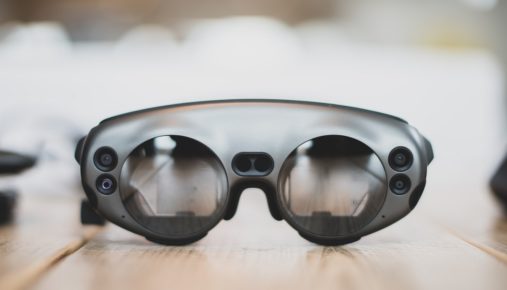When will augmented reality (AR) become a viable reality for today’s business environments?
The team at IFS Labs has been tracking the development of AR use cases and running experiments for years now. And without boring you with all of the promises and failures over those years, we can now really say that today AR has a lot of great things going.
Standardized platforms like ARCore and ARkit are heavily invested in by Apple and Google. We can access AR applications to our smartphones. Big new players are entering the head-mounted display market, while investments in existing devices like Microsoft HoloLens have increased. At the same time, for every single successful use case, many others are guilty of marketing fluff and hot air. Companies need to pick the right use cases to productize, while others have a lot of potential but are still in the experimental phase.
Head versus hand
First, it’s important to differentiate between AR use cases based on hand-held and head-mounted devices.
Hand-held devices
To put it simply, the most obvious benefit to handheld devices is that they’re cost-effective and already widely used by the enterprise workforce.
And since many enterprise solutions already have mobile apps, it’s easy to integrate new capabilities into these existing apps. The downside, however, is that hand-held devices have limited screen real-estate (especially mobile phones) and still require the user to hold the device in his or her hands (no hands-free).

Remote Assistance
As hand-held is by far the more mature option, especially combined with generally available platforms to develop AR capabilities, there are a number of options that are quite close to reality today. One such example is remote assistance. It allows a user to have an AR-enabled collaboration call with a peer, back-office engineering desk or an end customer. IFS Labs recently shared a preview of how this capability works in practice, with capabilities fully embedded in the IFS mobile applications. IFS will release this capability in 2020, making it available to our customers.
Head-mounted devices
Unlike handheld devices, with HMDs the user doesn’t need to use his or her hands and can view information overlaid on the real world, while still enjoying a hands-free experience. Some view the hands-free experience as the greatest benefit but also the wider view, larger screen real-estate and possible immersive experience are clear advantages.
On the downside, head-mounted devices are not yet as mature as the handhelds. In most cases the hardware is still very much “under development”, and most devices are still cumbersome when worn. There are also many different platforms with their own unique capabilities, and the price point is not economically feasible for mass adoption. That said, we believe now is the time to experiment with what HMDs can do for your business processes.
Case in Point: IFS Labs & Allinq
Allinq, an IFS customer, supports telecom operators and providers in designing, building, operating, maintaining and decommissioning of networks.
Allinq and IFS Labs have been collaborating to determine the impact of advanced smart glasses such as Microsoft HoloLens. Through their work together the two companies are determining how HMDs can change the way the field technician of the future works in these environments.

The Experiment
In Allinq’s business, quality of the work is of the utmost importance as their field workers perform repairs to critical telecom infrastructure elements, with no room for mistakes. For example, human errors could lead to the local internet network going down, or to large parts of the national telecom infrastructure being unavailable.
In short, avoiding downtime is a major benefit. Focusing more on quality than efficiency, the mixed reality models provide exact step-by-step instructions for those critical repairs.
Together IFS and Allinq understand that key in creating a proper field worker smart glasses experience, is considering two sides to such an application. Applications need to combine a standardized user interface (UI) providing context and data from the back-end business applications with customer-specific mixed reality models.
The challenge for those hungry to experiment
And that’s where the challenge lies.
IFS can deliver universal access to IFS solutions, providing the user with data, like the actual work order or task, asset information, historical work or even live IoT data. However, a customer will need to create mixed reality work instruction content for each and every one of the different tasks for all asset types that are relevant or critical in their business.
But, while, with the help of platforms like Vuforia, creating a model is no longer as complex or time consuming as it was a short while ago, there still is a significant amount of work to be done.
This is why it’s critical for challengers like Allinq to start now with smart experiments that take one aspect of your operations and explore what this technology could deliver for your business.
What’s next?
Field tests such as our Allinq collaboration are vital input to the development cycle of new innovations like advanced smart glasses. As there are plenty of challenges still to be overcome before these use cases are ready for productization, Allinq and IFS Labs will continue their collaboration to make these AR solutions a business reality in the future.
Learn more about IFS Labs at ifs.com.
Do you have questions or comments?
We’d love to hear them so please leave us a message below.
Follow us on social media for the latest blog posts, industry and IFS news!
Jessica Watson
Hello,
AR seems to be helpful, particularly for the different new businesses and even innovative mammoths. Therefore, given that that AR is most definitely going to control the tech world sooner than later, the distinct advantages of AR are not confined merely to this with evolving technology. There would be new updates in the future.
Thanks for sharing.
Jack
Hello,
Today AR is the most powerful Technology. Definitely, AR provides more freedom for the user and more possibilities for marketers.
Thanks for the valuable information.